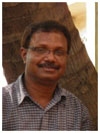 |
Mr. Kanwal Jit Singh
Proprietor,
Surbhi Financial Technologies, Pune
“Perspectives On EN ISO 14971:2012 & EN ISO
13485:2012”
The presentation
discusses the following aspects of:
• EN ISO 14971:2012
-
The content deviations
have been introduced in the EN standard for the
first time, and clarity is yet to be forthcoming
from Notified Bodies.
-
The presentation will
discuss the consensus arrived at in a discussion
between:
- Members of the committee ISO/TC 210/JWG 1
responsible for the development of ISO 14971:2007
- Convener of the Medical Device Working Group for
ISO 13485 at International Accreditation Forum
- Other members of the medical device community that
included the speaker
-
The work of the speaker
has been used by COCIR ( European Coordination
Committee of the Radiological, Electro-medical and
Healthcare IT Industry) in its submissions to Group
of Notified Bodies for arriving at a consensus
interpretation to the
Content Deviations introduction to the current EN
ISO 14971:2012 standard.
• EN ISO 13485:2012
-
Certain anomalies have
crept into the foreword to the standard, when read
in the context of establishing conformity with the
Essential Requirement of MDD and the associated
routes for assessing conformity.
-
There are certain issues
that have crept into industry practice for
implementing and assessing conformity to ISO
13485:2003 and its European Standard.
-
The issues are
experienced globally.
|
 |
Dr. Sanjeev Kumar Gupta
Managing Consultant
Intrust, Mumbai
“Risk Management: A Tool For
Certification Or A Smart Decision”
The
globalization of the medical device marketplace,
combined with the growth of medical device usage, has
led to a significant increase the complex task of
making a medical device safe for human use activity
among device manufacturers. Dear all, we know that
Medical Device (MD) and IVD products in market are
required to be safe. What is this safety? Regulation,
manufacturer and user interpret this differently but
still come down to a common acceptance of “reasonable
risks”, which of course depends on the magnitude of
the benefit. The stake holders try to maintain this
benefit-risk balance by making sure that products are
developed, tested, manufactured, labeled, prescribed,
dispensed, and used in a way that maximizes benefit
and minimizes risk.
A quick
revision of ISO 14971:2009 to ISO 14971:2012,
regulatory agencies examining risks in terms of the
worst possible outcome, and ever increase in warning
letters citing risk management deficiencies highlights
the importance of risk management, its linkage with
QMS processes more than ever before. And with this,
the roles of stake holders have evolved substantially
over the period with dramatic increase in scrutiny of
the product risk management practices.
Reduction in risks of failure of risk management is
not possible through a strictest regulation alone but
through a proactive vision which looks at risk
management beyond a “file for audit” to “basis for
decisions” throughout product’s life cycle. Inadequacy
in understanding and implementation fuels the
misguided notion that “risk management practices” adds
little value to design production and post production
stages. On the other hand a well executed risk
management serves as a powerful tool for innovation
and growth.
The
companies need to develop risk management processes
through cross functional involvement and integration
with other QMS processes, and robust governance by
management towards maximizing results and minimizing
risk. Most risk management processes fail in
demonstration of levels of risks & acceptability
criteria and identification of hazards as well as
confusion between hazard and risks. The risk
assessment is arbitrary and risk control measures
non-specific. Thus, the need of the hour is to unlearn
and relearn the concept and process of risk
management. Interesting examples shall be discussed
further. |
